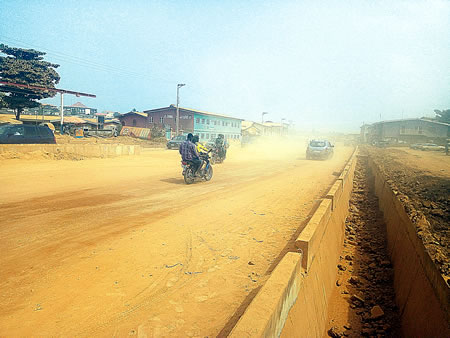Air pollution is a problem with major cities around the world. Air pollutants have been classified into two: particulate matter which includes solids (dust, smoke fumes), liquid (mist, spray) and hydrocarbons. The second class is gases which includes oxides of carbon, sulphur and nitrogen.
N30,000 minimum wage: NLC protest holds today as meeting with FG adjourned
Researcher, Adewale Matthew Taiwo of the Federal University of Agriculture, Abeokuta, in his work, “Particulate Matter Pollution in Nigeria: A Review,” asserts that Particulate Matter (PM) is a major air pollutant in the Nigeria atmospheric environment. One major source of PM pollution is when roads are being constructed. The effects of PM pollution on health due to road construction will be more pronounced in urban residential areas where the population density is high. It is important that authorities including NESREA, EIA Department, and others concerned with public do the needful to ensure that development does not take place at the expense of people’s health.
Health effects
The US Environment Protection Agency (EPA), speaking on health effects, says “the size of particles is directly linked to their potential for causing health problems. Small particles less than 10 micrometres in diameter pose the greatest problems, because they can get deep into your lungs, and some may even get into your bloodstream.
“Exposure to such particles can affect both your lungs and your heart. Numerous scientific studies have linked particle pollution exposure to a variety of problems, including: premature death in people with heart or lung disease, nonfatal heart attacks, irregular heartbeat, aggravated asthma, decreased lung function, increased respiratory symptoms, such as irritation of the airways, coughing or difficulty breathing.
“People with heart or lung diseases, children, and older adults are the most likely to be affected by particle pollution exposure.”
Who is at risk?
According to healthywa.wa.gov.au, “anyone who is exposed to high levels of dust may be affected – the longer you breathe in the dust, then the greater the chance that it will affect your health. Breathing low levels of household or urban dust does not cause health problems in most individuals. In contrast, people with existing respiratory and heart conditions, including smokers, are at greater risk of developing long-term health problems. Babies, young children and elderly people are also more likely to develop health problems from long term exposure to high levels of dust. Anyone who regularly experiences shortness of breath or hayfever type symptoms from breathing dust should discuss these symptoms with their doctor.”
PM pollution and road construction
Is it normal for air pollution by dust to accompany road constructions? Should the public accept it as something they should live with anytime there is a road construction? Prof. Akinwale Coker, Professor of Biomedical & Environmental Health Engineering, Department of Civil Engineering, University of Ibadan, in his response these questions said, “It is not unusual for a very minor level of air pollution by dust to accompany road constructions. However, the best practice is to largely minimise (if cannot totally prevent) such pollution, as air pollution is inimical to human health and could have fatal consequences in both short term and long term. The public should not accept it as something to live it anytime there is road construction. An accumulation of pollutants in human systems overtime could lead to debilitating disease of severe consequences.”
Best practices to reduce PM pollution
If the public does not have to live with air pollution because of a road construction, what then are best practices for road constructions which contractors should adhere to?
Professor Coker says the use of water to suppress dust immediately after generation; stabilise unpaved road surfaces as soon as constructed or better still, pave road surfaces as soon as constructed, or use mechanical road sweepers is what environmentally responsible road construction companies should do.
The Professor of Biomedical & Environmental Health Engineering provides more details:”Considering the health impact of dust on individuals, exposed to the hazards of inhaling dusts and other potentially harmful particulate materials, carried along with dusts during construction, there is need to adopt a sustainable approach in managing dust at road construction sites.
Sustainability in this regard applies to meeting objectives in a most affordable, and cost-effective way, and also with minimal environmental impact, both in terms of dust control treatment and the aggregate retention, through conservation of fines and road shape. It also means providing a level of service to road users that affords them safe and comfortable transportation and a nuisance-free environment
“In order to prevent this dust nuisance and the associated health hazard it poses, the simplest solution is to pave the road as quickly as possible, but due to the high cost, or sometimes the bureaucracy and bottlenecks affecting the timely completion of the projects, the road project can linger for a long period of time. Fortunately, there’s another solution that’s both affordable and effective: the use of dust palliatives.
“Dust palliatives are substances that prevent dust from entering the air. There are different dust palliatives to fit different needs and situations. Let’s look closer at the benefits of dust palliatives and which kind you need for your local roads.
“Depending on the situation, treating an unpaved road with an appropriate dust palliative generally limits the fines loss. Fines are the “glue” that holds the larger aggregates of an unpaved road together to form the surface layer. Keeping fines in the road leads to: Reduced dust levels; Improved safety and driver experience; Improved air and water quality by reducing particulate matter and sediment runoff; Improved quality of life of nearby residents; Extended intervals between gravel replacement needs; Reduced maintenance costs through extended intervals between grader blading needs; and reduced public complaints.
Dust palliatives are the agents applied to various road surfaces to prevent dust clouds and their environmental impact. The most commonly used dust palliatives are lignin sulfonate and magnesium chloride. Most dust palliatives are spread directly to the road surface. Preparation is minimal. Depending upon road usage and weather conditions, a maintenance plan with subsequent applications is recommended.”
Professor adds that, “Dust doesn’t just bother drivers and construction workers. Dust can also travel in the air and disturb visitors to parks, camping grounds, and other recreational areas. Dust palliatives prevent these dust-related issues and keep the air clean and clear.”
He further explained that professionals can evaluate a particular road to choose the right type of palliative. Along with assessing the road, they’ll also ask questions about the area and consider factors such as how many vehicles typically drive on the road, how much humidity and precipitation the area receives, and the gradation of the road’s materials.
“Certain kinds of dust palliatives are best for certain situations. On the other hand, some dust palliatives don’t work for certain conditions. There are a few points to keep in mind: If the road has fine dust. Lignosulfonates work best for controlling fine dust. If the road is not to be closed down for long, synthetic polymers should not be chosen as it takes up to 14 hours to dry. If the location is in a rural area with limited equipment, water may not be a feasible solution because of the huge need for regular access to water trucks. Moreover, one may not be able to use electrochemical stabilizers, either, because they require special equipment.
“Finally, the cost of the palliative and its potential impacts on the surrounding environment should be appropriately considered. It must be ensured that these palliatives will not damage local water or vegetation.”
On construction companies’ failure to adhere to the rules
Mr Suleiman Abass, Head, Environmental Impact Assessment (EIA) Division, Federal Ministry of Environment, said the EIA Act provides guidelines to minimise adverse impact of projects on the environment including air pollution. There are penalties also, he said, which will involve charging the erring contractor to court. Mr Abass however said judicial processes involved are fraught with bottlenecks.
Former chairman of Nigerian Society of Engineers (NSE) Ibadan Branch, Engineer Gbenga Ilori, said the rules regarding environmental impact are often flouted by road construction companies “because they know that nobody will hold them to account on environmental impact. That is why they do it as they please.”





